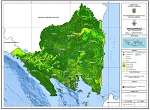
APPLICATION OF SPOT6/7 SATELLITE IMAGERY FOR RICE FIELD MAPPING BASED ON TRANSFORMATIVE VEGETATION INDICES
Abstract
Agriculture plays an essential role in national economic development. This fact made agricultural land one of the main unique production factors irreplaceable due to its importance in the agricultural business processes. However, a persistent problem of arable land conversion and land degradation have become more massive throughout the years. Meanwhile, the continuation of existing agricultural land and transformation into new agricultural land is inherently small. This research aimed to map agricultural land in sustainable agricultural development. Several transformative vegetation indices: NDVI, SAVI, and TSAVI, applied SPOT 6/7 satellite imagery in Lampung Province. Results show that the TSAVI value is the highest, with a 1.80 value, which indicates that this index value is very dense vegetation. Meanwhile, the NDVI index, which has a minimum value of -1.02, suggests that this index value is a non-vegetation object. However, high or low value does not indicate the rigorousness and Accuracy of an index. All three indices’ results are then overlaid with the satellite imagery classification process result. The accuracy result shows that the agricultural land has a maximum of 100% producer accuracy while the user accuracy value is 87.87%. Overall, for NDVI, the Accuracy was valued at 90.25%, which could be classified as a reasonable classification result. SAVI has a PA value of 97.85%, UA 85.20% and OA 86.63%, while the TSAVI Index has a PA value of 98.23%, UA 86.16% and OA 87.63%. This accuracy value indicates that the map has good results but judging from the magnitude of the highest accuracy value obtained from NDVI, it can be concluded that NDVI is the best index to determine paddy fields
Keywords: Agricultural Land, SPOT 6/7, NDVI, SAVI, TSAVI.
Full Text:
PDFReferences
Berutu, D. S. (2013). Aplikasi Penginderaan Jauh Dan Sistem Informasi Geografis Dalam Mengkaji Perubahan Luas Hutan Di Kabupaten Kuantan Singingi (Riau) Tahun 2000-2010. 10.
BIG. (2014). Pedoman Teknis Ketelitian Peta Dasar. Peraturan Kepala Badan Informasi Geospasial Nomor 15 Tahun 2014.
BPS. (2018). Luas Panen dan Produksi Padi di Provinsi Lampung. Lampung: Badan Pusat Statistik Provinsi Lampung.
BPS (2019). Lampung Dalam Angka. Dipetik 09 September 2019, dari https://lampung.bps.go.id/subject/53/lampung-dalam-angka.html
Dou, Y., Huang, R., Mansaray, L. R., & Huang, J. (2020). Mapping high temperature damaged area of rice rice along the Yangtze River using Moderate Resolution Imaging Spectroradiometer data. International Journal of Remote Sensing, 41(2), 471–486. https://doi.org/10.1080/01431161.2019.1643936
Gandhi, G. M., Parthiban, S., Thummalu, N., & Christy, A. (2015). Ndvi: Vegetation Change Detection Using Remote Sensing and Gis – A Case Study of Vellore District. Procedia Computer Science, 57, 1199–1210. https://doi.org/10.1016/j.procs.2015.07.415
Guan, X., Huang, C., Liu, G., Meng, X., & Liu, Q. (2016). Mapping Rice Cropping Systems in Vietnam Using an NDVI-Based Time-Series Similarity Measurement Based on DTW Distance. Remote Sensing, 8(1), 19. https://doi.org/10.3390/rs8010019
Huete, A., Didan, K., van Leeuwen, W., Miura, T., & Glenn, E. (2010). MODIS Vegetation Indices. Dalam B. Ramachandran, C. O. Justice, & M. J. Abrams (Ed.), Land Remote Sensing and Global Environmental Change (Vol. 11, hlm. 579–602). Springer New York. https://doi.org/10.1007/978-1-4419-6749-7_26
Kimura, R., Okada, S., Miura, H. & Kamichika, M. (2004). Relationships among the leaf area index, moisture availability, and spectral reflectance in an upland rice field. Agricultural Water Management, 69(2), 83-100. https://doi.org/10.1016/j.agwat.2004.04.009.
Kuenzer, C., & Knauer, K. (2013). Remote sensing of rice crop areas. International Journal of Remote Sensing, 34(6), 2101–2139. https://doi.org/10.1080/01431161.2012.738946
Lampung, B. P. (2015). Bandar Lampung dalam Angka Tahun 2015. Bandar Lampung: BPS Kota Bandar Lampung.
Lampung, B. P. (2018). Bandar Lampung dalam Angka Tahun 2015. Bandar Lampung: BPS Kota Bandar Lampung.
Lampung, B. P. (2018). Luas Panen dan Produksi Padi di Provinsi Lampung 2018 (Perbaikan Metodologi Perhitungan Data Produksi Beras dengan Metode Kerangka Sampel Area). Bandar Lampung: BPS Provinsi Lampung.
Li, P., Jiang, L., & Feng, Z. (2013). Cross-Comparison of Vegetation Indices Derived from Landsat-7 Enhanced Thematic Mapper Plus (ETM+) and Landsat-8 Operational Land Imager (OLI) Sensors. Remote Sensing, 6(1), 310–329. https://doi.org/10.3390/rs6010310
Li, Peng, Luguang Jiang, and Zhiming Feng. 2014. "Cross-Comparison of Vegetation Indices Derived from Landsat-7 Enhanced Thematic Mapper Plus (ETM+) and Landsat-8 Operational Land Imager (OLI) Sensors" Remote Sensing 6, no. 1: 310-329. https://doi.org/10.3390/rs6010310
Marinda, R., R.P. Sitorus, S., & Pribadi, D. O. (2020). Analisis Pola Spasial Persebaran Kawasan Lahan Pertanian Pangan Berkelanjutan Di Kabupaten Karawang. Jurnal Geografi, 12(02), 161. https://doi.org/10.24114/jg.v12i02.17646
Marino, Stefano; Alvino, Arturo. (2018) Detection of homogeneous wheat areas using multi-temporal UAS images and ground truth data analyzed by cluster analysis. European Journal of Remote Sensing 51:1, pages 266-275.
Mulla, D. J. (2013). Twenty five years of remote sensing in precision agriculture: Key advances and remaining knowledge gaps. Biosystems Engineering, 114(4), 358–371. https://doi.org/10.1016/j.biosystemseng.2012.08.009
Nadzir, Z. A., Simarmata, N., & Aliffia, A. (2020). Pengembangan Algoritma Identifikasi Sawah Padi Berdasarkan Spektra Fase Padi (Studi Kasus: Lampung Selatan) (Rice Field Identification Algorithm Development Using Spectral Value of Rice Field (Case Study: South Lampung)). JURNAL SAINS INFORMASI GEOGRAFIS, 3(1), 23. https://doi.org/10.31314/jsig.v3i1.537
Oguro, Y., Suga, Y., Takeuchi, S., Ogawa, H., & Tsuchiya, K. (2003). Monitoring of a rice field using landsat-5 TM and landsat-7 ETM+ data. Advances in Space Research, 32(11), 2223–2228. https://doi.org/10.1016/S0273-1177(03)90546-1
Park, S., Im, J., Park, S., Yoo, C., Han, H., & Rhee, J. (2018). Classification and Mapping of Rice Rice by Combining Landsat and SAR Time Series Data. Remote Sensing, 10(3), 447. https://doi.org/10.3390/rs10030447
Pertanian, K. (2018). Luas Sawah pada Fase Pertanaman Padi Data Satelit Landsat-8 Edisi 59 Periode 20 Juli-4 Agustus 2018. Bandar Lampung: BPS Lampung.
Pertanian, P. D. (2019, Juli). Diambil kembali dari Buku Statistik Data Lahan Tahun2012-2016: http://epublikasi.setjen.pertanian.go.id/epublikasi/statistik%20data%20lahan/Buku%20Statistik%20Data%20Lahan%20Tahun%202012-2016/files/assets/basic-html/page71.html
Prayuda, B. (t.t.). PANDUAN TEKNIS PEMETAAN HABITAT DASAR PERAIRAN LAUT DANGKAL. 29.
Raimadoya, M. A., Trisasongko, B. H., Zain, A., Hasbi, W., & Tahir, A. (t.t.). Analisis Misi Dan Rancangan Lapan-Ipb Satellite (Lisat) Untuk Pemantauan Kemandirian Pangan. 16(3), 6.
Ren, H., Zhou, G., & Zhang, F. (2018). Using negative soil adjustment factor in soil-adjusted vegetation index (SAVI) for aboveground living biomass estimation in arid grasslands. Remote Sensing of Environment, 209, 439–445. https://doi.org/10.1016/j.rse.2018.02.068
Robinson, N., Allred, B., Jones, M., Moreno, A., Kimball, J., Naugle, D., Erickson, T., & Richardson, A. (2017). A Dynamic Landsat Derived Normalized Difference Vegetation Index (NDVI) Product for the Conterminous United States. Remote Sensing, 9(8), 863. https://doi.org/10.3390/rs9080863
Rondeaux, G., Steven, M., & Baret, F. (1996). Optimization of soil-adjusted vegetation indices. Remote Sensing of Environment, 55(2), 95–107. https://doi.org/10.1016/0034-4257(95)00186-7
Sadali, M. I. (2018). Ketahanan Pangan Berkelanjutan Di Kabupaten Sukoharjo. 12.
Subiyanto, S., & Sukmono, A. (2015). Identifikasi Lahan Sawah Menggunakan Ndvi Dan Pca Pada Citra Landsat 8. 4, 9.
Tian, H., Wu, M., Wang, L., & Niu, Z. (2018). Mapping Early, Middle and Late Rice Extent Using Sentinel-1A and Landsat-8 Data in the Poyang Lake Plain, China. Sensors, 18(2), 185. https://doi.org/10.3390/s18010185
Vibhute, A. D., & Gawali, D. B. W. (2013). Analysis and Modeling of Agricultural Land use using Remote Sensing and Geographic Information System: A Review. International Journal of Engineering Research And, 3(3), 12.
Wang, S., Di Tommaso, S., Faulkner, J., Friedel, T., Kennepohl, A., Strey, R., & Lobell, D. B. (2020). Mapping Crop Types in Southeast India with Smartphone Crowdsourcing and Deep Learning. Remote Sensing, 12(18), 2957. https://doi.org/10.3390/rs12182957
Xue, J., & Su, B. (2017). Significant Remote Sensing Vegetation Indices: A Review of Developments and Applications. Journal of Sensors, 2017, 1–17. https://doi.org/10.1155/2017/1353691
Xue, Li-Hong., Cao, Wei-Xing., Luo, Wei-Hong., Wang, Shao-Hua. (2004). Relationship Between Spectral Vegetation Indices and LAI in Rice. Chinese Journal of Plant Ecology, 28(1): 47-52. https://www.plant-ecology.com/EN/10.17521/cjpe.2004.0007
Yeom, J.-M., Jeong, S., Deo, R. C., & Ko, J. (2021). Mapping rice area and yield in northeastern asia by incorporating a crop model with dense vegetation index profiles from a geostationary satellite. GIScience & Remote Sensing, 58(1), 1–27. https://doi.org/10.1080/15481603.2020.1853352
DOI: https://doi.org/10.24114/jg.v14i1.29036
Article Metrics
Abstract view : 283 timesPDF - 227 times
Refbacks
- There are currently no refbacks.
Accredited Journal, Based on Decree of the Minister of Research, Technology and Higher Education, Republic of Indonesia Number 36/E/KPT/2019
Copyright ©2020 Jurusan Pendidikan Geografi Fakultas Ilmu Sosial Universitas Negeri Medan dan Ikatan Geograf Indonesia (IGI)
This work is licensed under a Creative Commons Attribution-NonCommercial 4.0 International License.



















